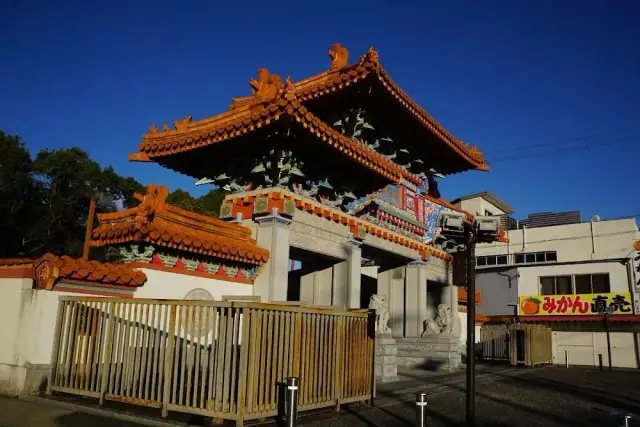https://www.dekitabi.com/itinerary/shingu-essential-half-day-tour
Nestled in the heart of Wakayama Prefecture, Shingu is a city that beautifully intertwines ancient history and spiritual significance with stunning natural landscapes. Shingu is home to several culturally and historically significant sites, including Kamikura Shrine, Kumano Hayatama Taisha Shrine, Shingu Castle Ruins, and Jofuku Park. Exploring these sites offers a deep dive into Japan’s rich heritage and spiritual traditions.
Kamikura Shrine: A Spiritual Ascent

https://www.dekitabi.com/attraction/kamikura-shrine
Perched high on a steep mountainside, Kamikura Shrine is one of Shingu’s most awe-inspiring spiritual sites. This ancient shrine is part of the Kumano Sanzan, the three grand shrines of Kumano, and is steeped in myth and legend. According to local lore, the shrine is the spot where the gods descended to Earth, making it a significant place of worship and pilgrimage.
The journey to Kamikura Shrine is an adventure in itself, involving a steep climb up a long flight of stone steps. The climb may be challenging, but the reward at the top is well worth the effort. The view from the shrine is breathtaking, offering panoramic vistas of the surrounding mountains and the city below. The shrine itself is a small, unassuming structure, but its spiritual significance and the serene atmosphere make it a must-visit.
Visitors often leave behind small offerings and prayers, seeking blessings and protection from the deities. The ancient trees surrounding the shrine add to the mystical ambiance, creating a sense of timelessness and tranquility. For those interested in Japanese mythology and spirituality, Kamikura Shrine is a place of profound beauty and reverence.
Kumano Hayatama Taisha Shrine: A World Heritage Site

https://www.dekitabi.com/attraction/kumano-hayatama-taisha
Kumano Hayatama Taisha Shrine is another cornerstone of Shingu’s spiritual landscape. As one of the Kumano Sanzan, it holds great religious significance and is part of the Sacred Sites and Pilgrimage Routes in the Kii Mountain Range, a UNESCO World Heritage Site. The shrine’s history dates back over a thousand years, and it continues to be a vital place of worship and cultural heritage.
The shrine is known for its beautiful architecture, featuring vermillion-painted structures that stand out vividly against the lush greenery. The grounds are meticulously maintained, with carefully landscaped gardens and ancient trees that add to the shrine’s serene atmosphere. One of the most famous trees here is the Nagi tree, which is over 800 years old and believed to bring good fortune.
Inside the shrine, visitors can see a collection of ancient artifacts and religious treasures, including traditional clothing and sacred objects used in rituals. The Kumano Hayatama Taisha Shrine also hosts several important festivals throughout the year, attracting pilgrims and tourists alike. These events offer a unique glimpse into the rich cultural and spiritual traditions of the region.
Shingu Castle Ruins: A Glimpse into the Past

https://www.dekitabi.com/attraction/ruin-of-shingu-castle
For history enthusiasts, the Shingu Castle Ruins provide a fascinating window into Japan’s feudal past. Although the castle itself no longer stands, the ruins and surrounding park offer a glimpse into its former glory. Originally built in the early 17th century, Shingu Castle played a crucial role in the region’s defense and governance.
Today, visitors can explore the remnants of the castle walls and foundations, imagining what life was like during its heyday. The site is also home to several informative plaques and displays, providing historical context and details about the castle’s construction and significance. The park surrounding the ruins is a lovely spot for a leisurely stroll, with well-maintained paths and beautiful views of the surrounding area.
One of the highlights of visiting the Shingu Castle Ruins is the opportunity to see the majestic views from the top of the hill where the castle once stood. The vantage point offers sweeping panoramas of Shingu City and the Kumano River, making it a popular spot for photography and quiet contemplation. The blend of natural beauty and historical intrigue makes the Shingu Castle Ruins a compelling destination for visitors of all ages.
Jofuku Park: A Tribute to an Ancient Legend

https://www.dekitabi.com/attraction/jofuku-park
Jofuku Park is a unique and tranquil spot in Shingu, dedicated to the legendary figure Jofuku (also known as Xu Fu), a Chinese alchemist sent by Emperor Qin Shi Huang to find the elixir of immortality. According to the legend, Jofuku arrived in Japan and settled in Shingu, where he introduced various medicinal herbs and agricultural techniques.
The park features a beautiful statue of Jofuku, along with a commemorative plaque that tells the story of his journey and contributions to the region. The gardens are meticulously landscaped, with a variety of plants and flowers that change with the seasons, offering a peaceful and picturesque setting for a relaxing walk.
Visitors can also explore the small museum located within the park, which houses artifacts and exhibits related to Jofuku’s legend and the historical connections between China and Japan. The park is a popular spot for both locals and tourists, offering a serene escape from the hustle and bustle of city life.
Jofuku Park also hosts an annual festival celebrating Jofuku’s legacy, featuring traditional music, dance, and food. This event provides a wonderful opportunity to experience local culture and traditions while learning more about this fascinating historical figure.
Conclusion
Shingu is a city that offers a rich tapestry of cultural and historical experiences, from the spiritual heights of Kamikura Shrine to the serene beauty of Jofuku Park. Whether you are seeking spiritual enlightenment, historical insights, or simply a peaceful escape into nature, Shingu has something to offer.
Kamikura Shrine’s steep ascent and breathtaking views provide a deeply spiritual experience, while Kumano Hayatama Taisha Shrine’s vibrant architecture and ancient artifacts offer a glimpse into Japan’s religious heritage. The Shingu Castle Ruins transport visitors back to the feudal era, and Jofuku Park celebrates a legendary figure whose story bridges cultures and centuries.
Exploring these sites allows visitors to connect with Japan’s rich history and traditions in a meaningful and memorable way. Each site offers its unique charm and significance, making Shingu a must-visit destination for anyone interested in Japan’s cultural and spiritual heritage.


Leave a Reply